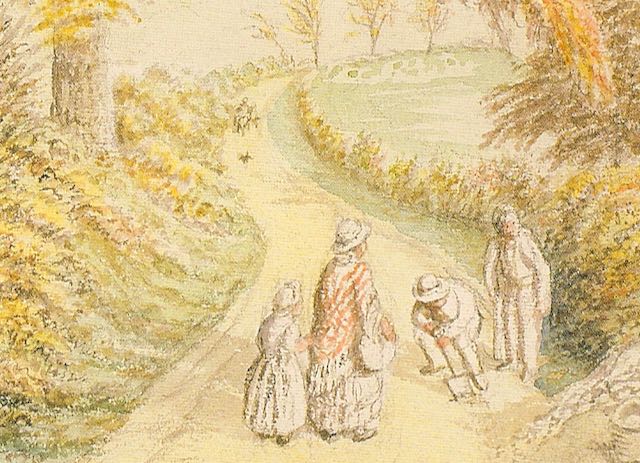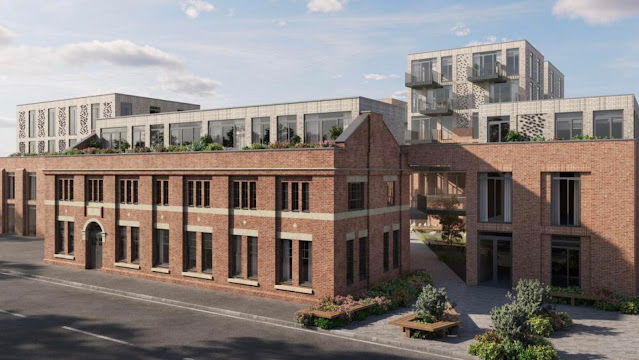 |
| Portion of a scene painted by John Buckingham (1800-1881) near the Camp Field at the foot of Camp Hill. Today the Campfield Road/Dellfield road junction is nearby. COURTESY ST ALBANS MUSEUMS |
Few of us with knowledge of the east side of St Albans will need a reminder of the location of today's blog. Leaving Hatfield Road at The Crown, descend Camp Road and pass under the Blue Bridge. At the very lowest ground and before climbing Camp Hill, turn left. This is Campfield Road. A small branch railway line arrived in the 1860s (the original reason for the bridge, although it wasn't blue then - in fact not the same bridge at all! The railway separated the growing Hatfield Road to the north from the dairy fields and hamlet of Camp Hill to the south. The artist John Buckingham, painting in the mid 19th century, portrayed this junction very effectively; the road ahead is Camp Hill.
 |
| 1930s homes line around half of Campfield Road as well as Valerie Close, Roland Street and one side of Sutton Road. |
We note that the Campfield Road of today is quite lengthy from Camp Lane (now Camp Road) to Sutton Road. The eastern section is largely semi-detached homes built c1930 by Mr W Stephens for the rental market. Before that date the field at the eastern end was used by the Oakley family to graze dairy cattle, and for the first decade of the 20th century was utilised as Fleetville's first recreation ground, mainly for the use of of local football teams. Along the boundary between the upper and lower fields ran a footpath from the oldest section of Camp Hill, downhill towards the stream bed and gently up the opposing slope towards Hatfield Road – opposite where today the western boundary of Fleetville Recreation Ground.
.jpeg) |
| The Miskin built structure as designed for George Orford Smith, including its manager's house before the site was extended for the Salvation Army's Campfield Press. |
 |
| The main workshop of the Musical Instrument Works. COURTESY SALVATION ARMY ARCHIVE |
 |
| The modified front building of the 1908 Electricity Works for the nearly completed new residential development. |
However, the works remained in business for only five years, and in 1900 an equally expensive winding up process took place and the buildings were sold on to the Salvation Army which moved its printing, and shortly after its musical instrument works, from the East End; that is, London's East End. The road, or rather track into the field, was called Campfields. The road's first iteration was barely longer than the works itself. However, the Salvation Army also acquired additional land, and so it was that the buildings for the city's electricity works was acquired from the Salvation Army's William Booth in 1908. The administrative building of the works still stands and is now being converted into residential accommodation to be known as The Old Electricity Works. New buildings for the development have been constructed at the rear on the site of the former generating furnaces.
 |
| Advertising by Engineering & Lighting Equipment Ltd COURTESY GRACES GUIDE TO HISTORY OF INDUSTRY |
 |
| The former Herts Advertiser building, now Phoenix House |
After a century publishing a newspaper in the centre of the city the Herts Advertiser moved out to the suburbs, and to a site known to all today as Phoenix House. In the 1960s the local news was published from here, and although the address is Camp Road, Phoenix lies along Campfield Road leaning against the hill which is Camp Hill.
On both sides of Campfield Road were temporary land uses during the Second World War; on the east side shelters were driven into the hillside; and on the west there were quarters for the Home Guard, and additional temporary buildings; de Havilland Aircraft Company occupied much of the Salvation Army Musical Instrument Works – later taken over by Boosey & Hawkes.
So, Camp Fields, or Campfield Road, a street of two halves; homes on the east and businesses on the west. Although nothing original remains on the railway side apart from a section of boundary wall, there is plenty of activity in the many industrial and business units which trade from here. And even more trade on the Sphere Trading Estate opposite.






1 comment:
I have a photo of my grandfather William Reynolds in an amateur football team (middle back row) in a field very close to the junction of Camp Road & Sutton Road. You could just make out the Beaumont Works (Nicholsons) behind them. It was dated c 1910. It's A pity I cannot cut and paste the pic to here. If you want a copy Mike. Leave your E Mail address ib your answer and I can send it to you by E Mail.
He worked at the Perkins-Mackintosh Well Drilling firn at Bernards Heath.
Post a Comment